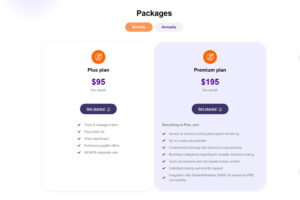In the face of tightening margins and unpredictable market shifts, budget shortfalls are a common concern for modern businesses. But what if these challenges could be reframed as opportunities? With the rise of real-time alerts, dynamic budgeting, and data-driven financial oversight, shortfalls can now be proactively managed—and even transformed into strategic wins.
Rather than waiting for end-of-month reviews to uncover overspending, businesses can now act in real-time, reallocating resources, tightening procurement decisions, and improving visibility across every department. This approach is especially relevant for practices and clinics where supplies, staffing, and operations must align precisely with cash flow.
What Are the Leading Causes of Budget Shortfalls?
Shortfalls don’t occur by accident—they’re usually the result of multiple small issues that compound over time:
- Inaccurate forecasting based on static budgets
- Manual tracking errors that misrepresent actual spend
- Delayed reporting cycles, where overspending isn’t identified until it’s too late
- Unexpected expenses—from supplier price changes to urgent maintenance
- Departmental silos, causing duplicate purchases or misaligned spending priorities
- Lack of visibility, especially in multi-location or fast-growing businesses
Addressing these pain points begins with building a real-time financial monitoring system that alerts you before problems escalate.
What Role Do Real-Time Alerts Play in Financial Visibility?
Real-time alerts are automated messages triggered when predefined thresholds are breached—such as excessive spend in a particular category, or budget variances beyond tolerance.
They allow:
- Instant notifications of financial risk
- Immediate action to curb unnecessary spending
- Real-time visibility across teams and departments
- Enhanced budget adherence through proactive monitoring
- Tighter procurement management and reduced stock wastage
Instead of waiting for quarterly reports to take corrective action, businesses can respond in the moment.
How Do Real-Time Alerts Compare to Traditional Budget Reviews?
| Feature | Real-Time Alerts | Traditional Budget Reviews |
| Frequency | Continuous | Monthly or Quarterly |
| Response Time | Immediate | Delayed |
| Risk Prevention | High | Low |
| Data Source | Live platforms | Static spreadsheets |
| Transparency | High – team-wide visibility | Often siloed |
| Flexibility | Dynamic and responsive | Fixed and retrospective |
This shift empowers businesses to move from reactive firefighting to strategic control.
Which Attributes Define a Successful Budget Adjustment?
To ensure financial resilience, the following attributes are essential:
- Timely insights – reacting before problems grow
- Strategic reallocation – not just cuts, but smart redistribution
- Department-level granularity – knowing where the issue lies
- Data-informed decisions – driven by live KPIs
- Cross-team collaboration – budgeting is no longer a finance-only function
These pillars underpin smarter financial governance across growing organisations.
What Advantages Come with Dynamic Budgeting?
A dynamic budgeting model means moving away from rigid yearly allocations and embracing flexible, performance-based spend planning. Benefits include:
- Reallocating underused funds in real time
- Making adjustments as needs shift (seasonal or operational)
- Forecasting future risks based on predictive analytics
- Avoiding over-ordering or double-spending across locations
- Driving more accurate financial KPIs for performance tracking
This approach encourages agility, responsiveness, and long-term budget optimisation.
Which Teams Gain the Most from Real-Time Spend Monitoring?
Any team handling operational spend will benefit, but the most common include:
- Procurement – for ordering, supplier management, and stock visibility
- Operations – where overspend can creep in subtly over time
- Marketing – campaign-based budgeting often requires closer monitoring
- HR and Admin – staff costs, recruitment, and consumables
- Finance – overseeing budget variance and ensuring alignment across teams
Spend tracking is no longer siloed—every team plays a role.
What Tools Support Real-Time Budget Management?
To put this strategy into action, you need a foundation of smart tools:
- Automated financial alerts based on thresholds
- Cloud-based dashboards for instant access across locations
- Expense categorisation for clearer tracking and reporting
- Live spend tracking across departments
- Customisable financial KPIs to define what success looks like
Together, these tools allow more agile, transparent, and accurate financial control.
What Steps Help Turn Shortfalls Into Wins?
Here’s a simple roadmap for implementation:
- Audit current tracking systems to identify gaps
- Implement a real-time platform with alert functionality
- Define thresholds and KPIs for each department or category
- Set alerts for key variances (weekly or cumulative)
- Train relevant teams on how to interpret and respond
- Review performance monthly to adjust alert settings and improve forecasting
This proactive approach gives you the power to identify waste, respond early, and allocate more intelligently.
Why Is Restocq the Smart Solution for Budget Control?
Restocq is a game-changing platform built by dentists, for dentists. It streamlines ordering, tracks spending in real-time, and sends automatic alerts when budgets are at risk—so you can take action fast.
No need to change how you pay your suppliers. Restocq simply brings all your ordering into one smart, cloud-based system, helping your team stay on budget without the admin headache.
With built-in reporting, live dashboards, and powerful financial insights, Restocq gives you the control to stop budget blowouts before they start—saving time, reducing waste, and protecting your bottom line.
What Research Supports These Strategies?
To support these strategies, the following references provide further context and validation:
- Australian Government – Department of Finance:
https://www.finance.gov.au/government/budget - CPA Australia – Budgeting & Financial Reporting Insights:
https://www.cpaaustralia.com.au/professional-resources/financial-reporting/budgeting - The Treasury – Real-Time Data Use in Economics:
https://treasury.gov.au/
Frequently Asked Questions
1. What is a real-time budget alert?
A real-time alert is an automated message triggered when your spend crosses a set threshold, helping you address overspending before it escalates.
2. Can smaller practices benefit from real-time alerts?
Absolutely. Smaller practices often see immediate benefits as they gain visibility into every dollar spent and prevent costly surprises.
3. What’s the difference between dynamic and static budgeting?
Static budgets are fixed annually. Dynamic budgeting allows for continuous updates based on real-time performance and shifting needs.
4. Do I need advanced financial knowledge to use a system like Restocq?
No. Restocq is user-friendly and designed for dental teams. It simplifies procurement, alerts, and spend tracking—all in one place.
5. How long does it take to see improvements?
Many businesses see improvements within weeks—especially around reduced ordering errors, better supplier control, and improved budget discipline.
6. Is Restocq only for multi-site dental groups?
No, Restocq works for both single-site and multi-site practices. It’s scalable to suit your size and structure.





